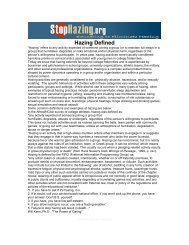Sorority Rituals - Reflections On Rites of ... - Mari Ann Callais
Sorority Rituals - Reflections On Rites of ... - Mari Ann Callais
Sorority Rituals - Reflections On Rites of ... - Mari Ann Callais
You also want an ePaper? Increase the reach of your titles
YUMPU automatically turns print PDFs into web optimized ePapers that Google loves.
necessary to develop two different theories to describe both sexes accurately. They argue that<br />
research should be conducted based upon this concept.<br />
Women’s Developmental Theory<br />
According to Muss (1988), Gilligan’s research and theories provide a major impetus for<br />
the rethinking <strong>of</strong> both developmental theory and the role <strong>of</strong> sex differences in theoretical<br />
conceptualizations. Gilligan, who worked with Kohlberg in earlier studies, presents a new<br />
perspective that challenges research to differentiate studies that addresses how males and females<br />
make moral judgments and, as a result, may differ in development. Kohlberg (1984) conducted<br />
studies concerning moral dilemmas, but originally conducted all <strong>of</strong> his research with males. He<br />
later gave moral dilemmas to females and identified them separately and he did find sex<br />
differences in the development <strong>of</strong> moral judgment. Gilligan (1982), however, took Kohlberg’s<br />
theory that states that development takes place at different stages, and created what she refers too<br />
as A Theoretical Consolidation: The Female Stages <strong>of</strong> Moral Reasoning. Through her studies,<br />
Gilligan discovered that female development is marked by the need for connectedness whereas<br />
males seek separation or individuality.<br />
In addressing the major differences between male and female moral reasoning, Gilligan<br />
(1982) maintains that the majority <strong>of</strong> males and females utilize two different voices. She states:<br />
<strong>On</strong>e <strong>of</strong> these voices, the one most commonly identified with the masculine world, speaks<br />
<strong>of</strong> preserving rights, exercising justice, obeying rules, and upholding principle; logical<br />
and individualistic, this male voice advocates equality, reciprocity, autonomy, and<br />
individualization; in short, this represents the justice orientation. The other voice, more<br />
dominant in women than in men, speaks <strong>of</strong> caring for others, sensitivity to others, concern<br />
for others, connectedness to others (p. 227).<br />
52



